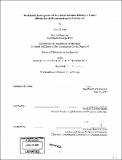| dc.contributor.advisor | JoAnne Stubble. | en_US |
| dc.contributor.author | Yee, Cyril S. (Cyril See-Min), 1974- | en_US |
| dc.contributor.other | Massachusetts Institute of Technology. Dept. of Chemistry. | en_US |
| dc.date.accessioned | 2005-06-02T18:25:44Z | |
| dc.date.available | 2005-06-02T18:25:44Z | |
| dc.date.issued | 2004 | en_US |
| dc.identifier.uri | http://hdl.handle.net/1721.1/17731 | |
| dc.description | Thesis (Ph. D.)--Massachusetts Institute of Technology, Dept. of Chemistry, June 2004. | en_US |
| dc.description | "May 2004." | en_US |
| dc.description | Includes bibliographical references. | en_US |
| dc.description.abstract | Ribonucleotide reductases (RNR) catalyze the conversion of nucleoside diphosphates to deoxynucleoside diphosphates, an essential step in DNA replication and repair. The Class I enzyme from Escherichia coli is composed of two subunits: R1 and R2. R contains the active site for nucleotide reduction and the allosteric effector sites that regulate the specificity and turnover rate. R2 contains the diferric-tyrosyl (Y.) radical cofactor that initiates nucleoside reduction by a putative long-range proton-coupled electron transfer (PCET) pathway over 35 A. This pathway is thought to involve specific amino acid radical intermediates (Y22-> W48-> Y356 within R2 to Y731-> Y730-> C439 within R1). In an effort to study radical initiation, we used intein technology to semi-synthetically synthesize R2 (375 residues) where Y356 is replaced with an unnatural amino acid. Thus far, we have replaced Y356 with 3- nitrotyrosine (NO2Y), 2,3-difluorotyrosine (2,3-DFY), 2,3,5-trifluorotyrosine (2,3,5-TFY), and 2,3,5,6-tetrafluorotyrosine (2,3,5,6-TFY). Titrations of the NO2Y-R2 construct allowed us to show that the pKa of the putative residue on the PCET pathway is minimally perturbed. In addition, the NO2Y-R2 construct showed no evidence of nucleotide reduction above background due to its increased oxidation potential compared to tyrosine (AE = 210 mV at pH 7.6), indicating that the radical initiation pathway can be shut down by a redox block at position 356. This model was further tested by replacement of Y356 with a fluorotyrosine series, which allowed us to vary both the redox potential ([Delta]E = 0-270 mV) and protonation state ([Delta]pKa = 2.2-4.4) of the residue at that position. | en_US |
| dc.description.abstract | (cont.) Consequently, we were able to reach a regime in which radical initiation became the rate-limiting step during catalysis. A Marcus fit of the pH-rate profile for the 2,3-DFY-, 2,3,5-TFY-, and 2,3,5,6-TFY-R2 constructs against wt R2 indicates that (a) Y356 is part of the radical initiation pathway (b) a proton can be removed from the pathway and (c) that the rate of radical propagation through Y356 is solely dependent on redox potential. Thus, we propose the literature model for PCET in RNR that radical migration occurs through hydrogen abstraction-cannot be valid. | en_US |
| dc.description.statementofresponsibility | by Cyril S. Yee. | en_US |
| dc.format.extent | 2 v. (297 leaves) | en_US |
| dc.format.extent | 11173088 bytes | |
| dc.format.extent | 11172886 bytes | |
| dc.format.mimetype | application/pdf | |
| dc.format.mimetype | application/pdf | |
| dc.language.iso | eng | en_US |
| dc.publisher | Massachusetts Institute of Technology | en_US |
| dc.rights | M.I.T. theses are protected by copyright. They may be viewed from this source for any purpose, but reproduction or distribution in any format is prohibited without written permission. See provided URL for inquiries about permission. | en_US |
| dc.rights.uri | http://dspace.mit.edu/handle/1721.1/7582 | |
| dc.subject | Chemistry. | en_US |
| dc.title | Mechanistic investigations of the radical initiation pathway of class I ribonucleotide reductase from Escherichia coli | en_US |
| dc.type | Thesis | en_US |
| dc.description.degree | Ph.D. | en_US |
| dc.contributor.department | Massachusetts Institute of Technology. Department of Chemistry | |
| dc.identifier.oclc | 56473611 | en_US |
